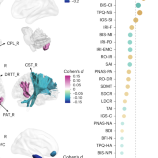
Articles
-
Nov 21, 2024 |
nature.com | Wilson X. Mai |Kai Song |Nicholas Bayley |Jiyoon Kim |Henan Zhu |Pauline Young | +14 more
Genomic profiling often fails to predict therapeutic outcomes in cancer. This failure is, in part, due to a myriad of genetic alterations and the plasticity of cancer signaling networks. Functional profiling, which ascertains signaling dynamics, is an alternative method to anticipate drug responses. It is unclear whether integrating genomic and functional features of solid tumours can provide unique insight into therapeutic vulnerabilities. We perform combined molecular and functional characterization, via BH3 profiling of the intrinsic apoptotic machinery, in glioma patient samples and derivative models. We identify that standard-of-care therapy rapidly rewires apoptotic signaling in a genotype-specific manner, revealing targetable apoptotic vulnerabilities in gliomas containing specific molecular features (e.g., TP53 WT). However, integration of BH3 profiling reveals high mitochondrial priming is also required to induce glioma apoptosis. Accordingly, a machine-learning approach identifies a composite molecular and functional signature that best predicts responses of diverse intracranial glioma models to standard-of-care therapies combined with ABBV-155, a clinical drug targeting intrinsic apoptosis. This work demonstrates how complementary functional and molecular data can robustly predict therapy-induced cell death. Genomic profiling of tumours can help tailer treatments to the patient, however, it often fails to accurately predict therapeutic outcomes. Here, the authors combine molecular and functional characterisation via BH3 profiling to identify therapeutically targetable vulnerabilities in glioma.
-
Oct 1, 2024 |
nature.com | Wei Liu |Bin Zhou |Xiaodong Luo |Gang Li
Generalized Anxiety Disorder (GAD) is a chronic anxiety condition characterized by persistent excessive worry, anxiety, and fear. Current diagnostic practices primarily rely on clinicians’ subjective assessments and experience, highlighting a need for more objective and reliable methods. This study collected 10-minute resting-state electroencephalogram (EEG) from 45 GAD patients and 36 healthy controls (HC), focusing on six frontal EEG channels for preprocessing, data segmentation, and frequency band division. Innovatively, this study introduced the “Differential Channel” method, which enhances classification performance by enhancing the information related to anxiety from the data, thereby highlighting signal differences. Utilizing the preprocessed EEG signals, undirected functional connectivity features (Phase Lag Index, Pearson Correlation Coefficient, and Mutual Information) and directed functional connectivity features (Partial Directed Coherence) were extracted. Multiple machine learning models were applied to distinguish between GAD patients and HC. The results show that the Deep Forest classifier achieves excellent performance with a 12-second time window of DiffFeature. In particular, the classification of GAD and HC was successfully obtained by combining OriFeature and DiffFeature on Mutual Information with a maximum accuracy of 98.08%. Furthermore, it was observed that undirected functional connectivity features significantly outperformed directed functional connectivity when fewer frontal channels were used. Overall, the methodologies developed in this study offer accurate and practical identification strategies for the early screening and clinical diagnosis of GAD, offering the necessary theoretical and technical support for further enhancing the portability of EEG devices.
Try JournoFinder For Free
Search and contact over 1M+ journalist profiles, browse 100M+ articles, and unlock powerful PR tools.
Start Your 7-Day Free Trial →